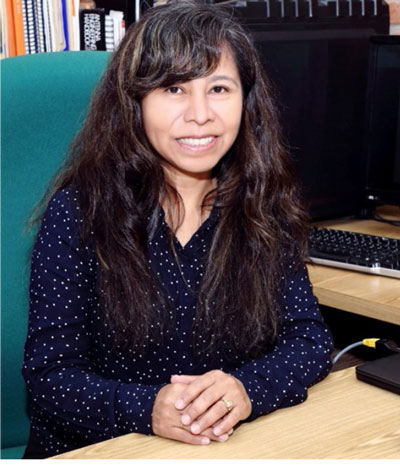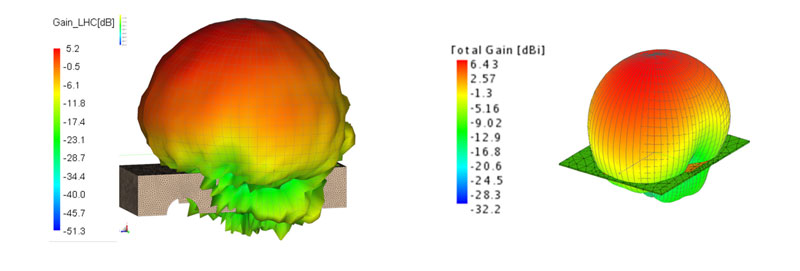Traditional TV antennas are available in indoor and outdoor varieties. One example of an indoor product is the dipole antenna. Also called “rabbit ears,” dipole antennas typically sit on top of or next to a TV to help improve reception.
A Yagi-Uda antenna, referred to as a “Yagi” antenna, is designed for outdoor use. It provides a directed beam that points towards a TV tower, permitting a high degree of signal reception.
The UAEM antenna is actually an array of two antennas that receive analog and digital broadcast channels. According to Tecpoyotl-Torres, the device is a compact rectangle that can be fixed to a roof without an attached mast and can operate under very low temperatures.
It can also be used indoors and run through a signal splitter to connect to multiple TVs. It does not require electricity/ power to operate.
This powerhouse antenna is 11 cm in length, 7 cm wide and 6.5 mm thick. Without a cover, the antenna weighs 12 g, and when coated, the antenna’s weight is only 80 g. Tecpoyotl-Torres explains that prior to the introduction of the UAEM antenna, the smallest conventional antennas measured 30 x 30 cm2
Design Considerations
When the antenna project began a few years ago, the objective was not necessarily to design the world’s smallest antenna but to develop one that was a low-cost alternative for people who did not have access to cable. Researchers wanted to deliver better over-the-air digital signal reception.
In the process of doing so, TecpoyotlTorres and her students focused on antenna design technology, material and the antenna cover, or radome.
From various antenna design options, the team selected a “patch antenna” approach. Rectangular in external shape, this antenna consists of a piece of metal mounted over a dielectric and a metal ground plane. The simple geometry of the antenna’s arrangement and shape enabled the team to add elements and optimize the design to locate the best frequency response.
The patch material is proprietary, as is the material used in the radome. While not at liberty to discuss the patch material, Tecpoyotl-Torres explains that the radome material is characterized as reliable, light and inexpensive, with an outdoor shelf life of 10 years.

“We use Altair Feko to simulate our designs because of its high accuracy and performance, allowing widely reliable implementations. Its computational technology and friendly interface make complex designs easier to simulate and optimize. We have reduced the time and costs in the development of our prototypes.”
— Dr. Margarita Tecpoyotl-Torres
“The combination of the antenna’s simple geometry, the elements we combined and the high-quality materials selected were important to the final result,” says Tecpoyotl-Torres. “The most important design parameter we considered was the reflection coefficient, which makes it possible for the antenna’s good response.”
Tools of the Trade
Several years ago, UAEM received a license from Altair to use its Altair Feko™ electromagnetic simulation soft ware. The solution enables users to analyze 3D antenna designs, placements, electromagnetic compatibility and radome layers, among others.
Prior to simulation tools, antenna design involved a lot of “cut-a d-try” work, in which concepts were developed, measured in a special chamber and physically fabricated — a potentially expensive process. With the implementation of simulation software, however, researchers have been able to quickly create and optimize their concepts.
They can experiment with materials and geometric shapes without having to test multiple iterations in the chamber. Once they identify a “good” concept, researchers can fabricate it and use the chamber to validate the design.
Tecpoyotl-Torres explains, “We use Altair Feko to simulate our designs because of its high accuracy and performance, allowing widely reliable implementations. Its computational technology and friendly interface make complex designs easier to simulate and optimize. We have reduced the time and costs in the development of our prototypes.”
The development of the antenna, patented in 2015, led to the creation of a spin- off company, In ntecver, S. A. de C.V., which is looking for opportunities to commercialize and mass produce the new technology. Researchers are also eyeing the European market. This segment is more interested in an indoor version of the antenna, which would require revisions to the device.
A New Focus: GPS
In addition to TV antenna design, Tecpoyotl-Torres and her team have investigated compact antenna designs for automotive Global Positioning System (GPS) use. GPS is a navigation device that relies on satellite technology to pinpoint locations; it can reduce the time of a journey, fuel consumption and fuel emissions.
Introduced in Mexico about four years ago, GPS localization has been marginal. As such, Tecpoyotl-Torres and her team decided to research the best placement for GPS antennas on cars. They studied the use of an antenna without a radome and with an acrylic radome. An important element of the investigation was taking into consideration the performance of the complete system rather than just the antenna. Studying the complete system provided a more accurate response of the elements the team was trying to design.
Tecpoyotl-Torres explains that they designed a circular patch antenna operating at 1.57 GHz with a unique feed point. The substrate was RT/Duroid 5880, a high-frequency laminate.
The team established three measurement points on campus. Results were compared with a Garmin GPS.
Initially, researchers used Feko to create a simplified car model to perform analysis of the antenna on the car. Then, they imported the CAD geometry from the car manufacturer into Altair Feko. Because the CAD model was so detailed, it took a week to run the job and receive the results.
 GPS antenna on rectangular car
GPS antenna on rectangular car
The team decided to simplify the CAD model in Altair Feko, eliminating components like nuts and bolts that did not contribute to the analysis. Doing so enabled the job to run in half the time without losing any accuracy.
The team considered three types of car models in order to analyze the influence of the chassis shape: basic car model (BCM), simplified advanced car model (SACM) and more simplified advanced car model (MSACM). In addition, they studied gain — the directionality of a given antenna — under circular polarization (how the electric fields oscillate, in this case).
The team learned a great deal in their research efforts. For example, they observed the biggest gain values of the simulated SACM and MSACM cases correspond to antenna placement on the center of the car roof. However, for aerodynamic behavior, the antenna is often located on the rear part of the car, and sometimes on the trunk.
With the average values of the experimental tests using the GPS kit in fixed points, the tea m concluded that their prototype has an adequate response as a replacement antenna. In practical measurements on a vehicle, the results were also satisfactory: All measured points corresponded to the campus circuit, as they were noted in the sampling points located using Google Maps.
Recently, other antenna designs have been developed for GPS including one based on pentagonal geometry, which individually provides a bigger gain value than a circular one.
Tecpoyotl-Torres concludes, “ We estimate the reduced time to be the most important benefit of using Altair Feko. When comparing it with other programs, design time was reduced by 50%, making concept to reality faster and less expensive.”
For more information on antenna and GPS applications, visit www.altair.com/antenna.
Beverly A. Beckert is Editorial Director of Concept To Reality.
By Beverly A. Beckert